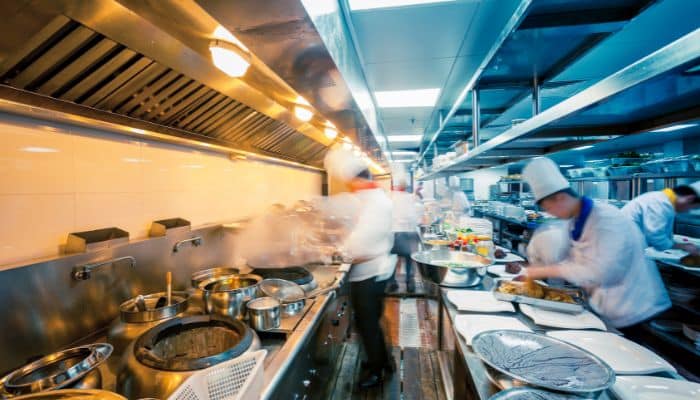Serve Up Safety With These 6 Tips for Preventing Foodborne Illness at Your Restaurant
Food safety is of the highest priority for restaurant businesses. From inventory control to food preparation, you always want to live by your promise to serve the freshest ingredients possible. The last thing you want is to give your loyal customers food poisoning.
As a restaurant owner, awareness of the most common foodborne illnesses is essential. Enforcing food safety protocols among all staff and suppliers is equally important. Here are the different food pathogens to look out for and how to optimize food safety at your eatery.
Types of Foodborne Illnesses Found at Restaurants
If you’re not careful, foodborne illnesses can spread like wildfire throughout your establishment. According to a study by the U.S. Centers for Disease Control and Prevention, there were 800 foodborne illness outbreaks across 25 states from 2017 to 2019 — 47% were norovirus and 18% were salmonella. The majority of cases derived from contamination and infected workers.
Overall, there are 48 million foodborne illness cases annually, most often of the following pathogens:
- Salmonella
- Norovirus
- E coli
- Campylobacter
- Hepatitis A
- Listeria
As the most common foodborne illness, norovirus symptoms typically appear one to two days after infection — some people experience the effects 12 hours after eating contaminated food. Symptoms usually include vomiting, diarrhea, cramps, mild fever, bodily aches and headache.
Staying abreast of the latest outbreaks is critical as food may be contaminated before it arrives in your inventory order.
6 Tips to Protect Patrons From Foodborne Illnesses
A foodborne illness outbreak at your restaurant is never good for business. Aside from making your customers sick, you could damage your reputation for safety and cleanliness. To protect patrons and your bottom line, follow these six tips to prevent foodborne illnesses.
Enforce Handwashing
Safeguarding staff and patrons from foodborne illnesses is as straightforward as practicing good hygiene. According to the Environmental Health Specialists Network, nine out of 10 illness outbreaks in restaurants are caused by germs spread by food workers’ hands.
Hang signs in bathrooms and the kitchen to remind employees to wash their hands before returning to work. Providing clean handwashing stations with warm water, soap and paper towels is also essential.
Sanitize Regularly
Sanitizing all surfaces is another way to prevent foodborne illnesses in your restaurant. However, cleaning must be thorough, especially in food contact areas.
Train employees on the proper cleaning and sanitizing procedures, from food preparation stations to cooking equipment to dining tables. While general cleaning will remove food debris and dirt, sanitization will eliminate harmful bacteria and pathogens.
Store your cleaning supplies appropriately and check the labels for instructions. Manufacturers may have specific recommendations for sanitizing utensils and appliances in solutions like iodine and chlorine.
Avoid Cross Contamination
Thoroughly washing hands and surfaces also helps prevent cross-contamination. Restaurant managers should be concerned about three areas of contamination — bacterial or viral, allergen, and chemical.
For instance, animal protein can spread salmonella — the second most prevalent bacterial outbreak — if not handled properly. Interactions between food and cleaning solutions are another example of harmful contamination. Even drinking water can be infectious, so check if it looks foggy or dirty before serving.
Customers might also have food allergies to nuts, seafood and eggs. Ensuring a clean and well-sanitized environment will prevent cross-contamination and avoid adverse reactions to food.
Check for Doneness
Serving raw or undercooked meat dishes can lead to significant foodborne illness outbreaks. Therefore, using a meat thermometer to check for doneness and kill off germs is critical. The minimum safe internal temperatures for animal protein are as follows:
- Poultry: 165 degrees Fahrenheit
- Beef: 145 Fahrenheit
- Pork: 145 Fahrenheit
- Venison: 160 Fahrenheit
- Seafood: 145 Fahrenheit or until the flesh is no longer translucent
There is a much lesser chance of food poisoning when these products are cooked through.
Practice Temperature Control
Storing food at the appropriate temperature is equally essential to checking for doneness. Restaurants should always check and recalibrate thermometers on refrigerators and freezers to avoid storing items outside dangerous temperature ranges.
Set your refrigerator below 41 Fahrenheit and the freezer to zero degrees or less. It is also critical to be aware of thawing times and temperatures. For instance, food must be cooled from 135 Fahrenheit to 70 Fahrenheit in two hours or less in a refrigerator, under cold water or microwave.
If you check your refrigerators or freezers and find foods close to their expiration dates or already expired, use or dispose of them properly.
Adhere to Health Regulations
Undergoing a health inspection is one of the most effective ways to hold you and your staff accountable for restaurant safety. A health inspector will look for all the components of a healthy restaurant operation and a few more items like pest control, setup and storage.
Don’t simply wait for the health inspector, though. You can use their checklists to audit your establishment yourself. Self-inspections drive home the importance of adhering to food safety.
Prioritize Food Safety for Everyone
Foodborne illnesses affect everyone’s health, from the customers to your staff and the business itself. Take the necessary precautions for food safety at your restaurant and throughout your supply chain. Quality food will have customers coming back for more.



Comments are closed.